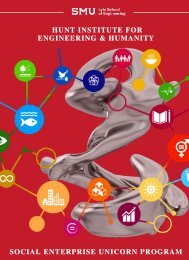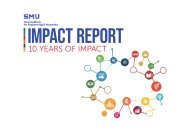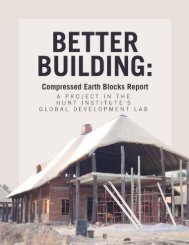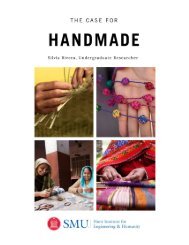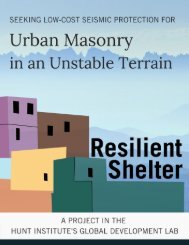Assessment of Rwanda Refugee Camps in the Context of the Villagization Process
Undergraduate researcher for the Hunt Institute for Engineering and Humanity and Engaged Learning Fellow Sienna Dugan, researched secondary sources and primary research through site visits, participatory observation, and interviews with key informants to compile this report which is structured like a case study with additional literature review. All photography is original to the student from her in-field research.
Undergraduate researcher for the Hunt Institute for Engineering and Humanity and Engaged Learning Fellow Sienna Dugan, researched secondary sources and primary research through site visits, participatory observation, and interviews with key informants to compile this report which is structured like a case study with additional literature review. All photography is original to the student from her in-field research.
Create successful ePaper yourself
Turn your PDF publications into a flip-book with our unique Google optimized e-Paper software.
Figure 1: SMU Lyle School of Engineering Logo
Figure 2: UNHCR Rwanda Logo
Assessment of Rwanda Refugee Camps in the Context of the
Villagization Process
By: Sienna Dugan
Figure 3: Mahama Refugee Camp
Table of Contents
Executive Summary ............................................................................................................... 3
1.0 Introduction ................................................................................................................ 5
1.1 UNHCR and Human Rights Documents ..................................................................................7
1.2 Rwanda Background and CRRF .............................................................................................9
1.3 Research Objectives............................................................................................................... 11
2.0 Methods ......................................................................................................................... 12
3.0 Results ........................................................................................................................... 13
3.1 Objective 1............................................................................................................................. 13
3.1.1 Characteristics of the Overall Population as of August 2019: ............................................................. 14
3.1.2 Disease ....................................................................................................................................................... 16
3.1.2 Education .................................................................................................................................................. 18
3.1.3 Infrastructure ........................................................................................................................................... 19
3.1.4 Water, Sanitation and Hygiene (WASH) ............................................................................................... 20
3.1.5 Nutrition .................................................................................................................................................... 20
3.1.6 Income ....................................................................................................................................................... 20
3.2 Objective 2............................................................................................................................. 21
3.3 Objective 3............................................................................................................................. 26
4.0 Discussion ..................................................................................................................... 28
5.0 Conclusion .................................................................................................................... 32
Executive Summary
The world is currently experiencing the highest rate of displaced people, 149,602 of whom
are seeking shelter in refugee camps in Rwanda. The United Nations High Commissioner for
Refugees (UNHCR) assumes the majority of responsibility for these people offering protection
and ensuring adequate standards of living. Established in 1850, UNHCR has since worked to
codify international refugee law rooted in Article 14 of the Universal Declaration of Human
Rights. Although various documents such as the UNHCR Handbook for Emergencies and the
Sphere Project Humanitarian Charter outline minimum standards for maintaining refugee camps,
new issues continue to arise from prolonged displacement.
Continuously in search of sustainable solutions for refugees and refugee camps, UNHCR
Rwanda has recently adopted the Comprehensive Refugee Response Framework (CRRF) which
aims to ease pressures on host countries; enhance refugee self-reliance; expand access to thirdcountry
solutions; and support conditions in countries of origin for return in safety and dignity.
With aims to have all refugees, including potential new influxes, living safe, dignified, and
productive lives outside of camps, supported by governmental services and programs by 2030,
processes to transform Mahama Camp into a self-sustaining village have begun to be explored.
The methodology used for this report is primarily the case study approach and additionally
a literature review. Further data was collected from cite visits, participatory observation, and
interviews with key informants. The objectives are to assess the current condition of refugee
camps in Rwanda providing a by sector analysis of needs focusing on Mahama Camp, identify
how UNHCR Rwanda is using CRRF to respond to the protracted and growing refugee situation
3
as it transitions out of being categorized as an emergency situation and determine best practices
on and viability of villagization for Mahama Refugee Camp.
The results section of this paper is divided by research objectives. The first provides a by
sector analysis of the refugee camps in Rwanda focusing on Mahama. Information is provided on
the sectors of highest concern. Next, data regarding the implementation of CRRF is provided.
Lastly, information regarding next steps and analysis of other case studies regarding the process
of villagization is offered.
Findings of this study show that attention must be focused on the construction and
rehabilitation of infrastructure and WASH facilities. Most specifically, measures to combat the
effects of erosion and overcrowding must be implemented. Secondly, although CRRF promotes
the autonomy of refugees and the host community through the integration of schools, water
filtration systems, and the shift to cash-based assistance, the traditional layout of refugee camps
hinders the self-reliance of refugees. Conversion of Mahama to a refugee city are contingent upon
the development of commerce zones, increased agricultural activities, and desire of the refugees
to integrate into the Rwandan community.
After successful implementation of CRRF, Rwanda’s response to their prolonged refugee
situation can be used as a transferable and scalable model for other countries seeking long term,
sustainable solutions.
4
1.0 Introduction
By the middle of 2018, 70.8 million individuals were forcibly displaced worldwide as a result
of persecution, violence, conflict, or human rights violations. This is the highest proportion of
forcibly displaced people the world has ever seen. As of February 2019, Rwanda alone hosted
149,602 refugees and asylum seekers of which 52.0% derived from the Democratic Republic of
Congo; hosted in five camps, and 47.6% from Burundi; hosted in Mahama Camp and other urban
areas.
In order to ensure protection and multi-sectoral assistance to all refugees and asylumseekers
in Rwanda, the Office of the United Nations High Commissioner for Refugees (UNHCR)
works in collaboration with the Government of Rwanda (through the Ministry of Disaster
Management and Refugee Affairs - MIDIMAR), in the various sectors of protection and material
assistance (see Figure 2). Furthermore, UNHCR acts as a managing body to enforce minimum
standards of wellbeing in Refugee camps around the world through partnering with other nonprofits,
NGO’s, and governmental agencies. Together, they work to assure that life within refugee
camps fulfill international standards for adequate living conditions through providing services like
access to healthcare, education, food, and infrastructure, while working to improve and maintain
environmental and electrical processes. With plans to have all refugees in Rwanda living safe,
dignified, and productive lives outside of camps by 2030, a needs analysis must be conducted and
best practices for strategic objectives identified. In order achieve this goal, UNHCR has begun to
explore the possibility of implementing their camp transformation plan which provides a
framework for the transformation of refugee camps into settlements, yielding full integration into
community infrastructure/systems for education, healthcare, water supply, sanitation, energy, and
environmental protection.1
1 United Nations. (2014). UNHCR Policy on Alternatives to Camps. Retrieved from
https://www.unhcr.org/protection/statelessness/5422b8f09/unhcr-policy-alternatives-camps.html
6
1.1 UNHCR and Human Rights Documents
In 1950, the office of the United Nations High Commissioner for Refugees (UNHCR) was
formed in response to the high level of Europeans whom had fled or lost their home as a result of
the Second World War. Today, over 68 years later, UNHCR is working to provide protection to
what is referred to as the “Global Refugee Crisis”. With 70.8 million people forced from their
homes, this is the highest level of displacement on record. The latest data published by the United
Nations High Commissioner for Refugees, separates these persons into four categories: Internally
Displaced Persons (IDP’s), Refugees, Stateless Persons, and Asylum Seekers.
In 1951, UNHCR ratified the 1951 Convention Relating to the Status of Refugees which
is rooted in Article 14 of the Universal Declaration of Human Rights (UDHR) stating that
“everyone has the right to seek and to enjoy in other countries asylum from persecution”.2
Subjected to an amendment in 1967, which removed the geographic and temporal limits of the
convention, this document serves as the most comprehensive codification for the rights of refugees
accepted on the international level. Rooted in fundamental principles of non-discrimination, nonpenalization,
and the treatment of refugees in concordance with fundamental human rights and
freedoms without discrimination as to sex, age, disability, sexuality, or other prohibited grounds
for discrimination, this document provides a framework to assure an adequate standard of living.
With ongoing increasing levels of development through transportation and communication, the
world in experiencing higher rates of the movement of people, goods, and information across
borders. Although these include voluntary movements, such developments have also resulted in
the involuntary movement of persons in response to increased violence as a repercussion of the
2 “Universal Declaration of Human Rights.” United Nations, United Nations, 1948, www.un.org/en/universal-declaration-humanrights/index.html.
development of weapons of mass destruction. The growing number of internationally displaced
persons has now made this of the most complicated issues of the world. In search of the most
effective way to assist such vulnerable groups UNHCR is working diligently with partner
organizations to achieve international cooperation in solving international problems of an
economic, social, cultural, or humanitarian character.3
Although created in response to those displaced in repercussion to WWII, UNHCR now
reports that the world is currently witnessing the highest levels of displacement on record, half of
whom displaced are under the age of 18. Although numbers of those displaced continue to
increase, rates of resettlement in other countries continues to decrease. In addition to this, a
majority of those in seek of refuge are generated from and hosted in Asia and Africa. With
increasing numbers of displaced persons, reintegration strategies, which often fall outside of the
mandate of UNHCR are continuously being explored. These strategies are complex and often
unsustainable.
Further research for creative solutions to prolonged displacement must be
conducted.
3 “Background on the Right to Development.” OHCHR, www.ohchr.org/EN/Issues/Development/Pages/Backgroundrtd.aspx.
8
1.2 Rwanda Background and CRRF
In 2015, political unrest peaked in Burundi displacing an estimated 400,000 people, many
of whom have sought shelter in Rwandan refugee camps. Generally, when refugee camps are
established, those seeking shelter within them often have only two choices. These include
voluntary repatriation for those brave enough to return home or resettlement in another
country.4 Because of the current global refugee crisis, an irregular and complex alternative has
started to be explored, the integration and nationalization of these refugees within their host
community.
This process has been standardized through the recent development of the
Comprehensive Refugee Response Framework (CRRF) which aims to ease pressures on host
countries; enhance refugee self-reliance; expand access to third-country solutions; and support
conditions in countries of origin for return in safety and dignity.5 Integration into communities
in response to “emergency development” have been documented through the process of
settlement programs, most notably in Ethiopia and Tanzania. Before integration policies are
implemented, it is instrumental that the communities are first transformed to independently
meet the Sphere guidelines of sustainability. 6 These guidelines focus on the four areas of
response: water supply, sanitation and hygiene promotion (WASH); food security and nutrition;
shelter and settlement; and health. In order to offer support in these sectors in alignment with the
CRRF framework, partner agencies and government counterparts are working to implement
4 UNHCR Policy Framework and Implementation Strategy: UNHCRs Role in Support of the Return and Reintegration of Displaced Populations:
, August 2008. (2009). Refugee Survey Quarterly,28(1), 205-221. doi:10.1093/rsq/hdp011
5 United Nations. “Comprehensive Refugee Response Framework.” UNHCR, 2018, www.unhcr.org/comprehensive-refugee-responseframework-crrf.html.
6 Project, T. S. (2011). Humanitarian Charter and Minimum Standards in Humanitarian Response. doi:10.3362/9781908176202
9
sustainable response systems with an emphasis on integrated service delivery with host
communities. In Mahama Camp, the prolonged status of refugees has necessitated the adoption of
long-term development solutions that will promote self-reliance and autonomy. The long-term
vision in Rwanda aims to have all refugees, including potential new influxes, living safe, dignified,
and productive lives outside of camps, supported by governmental services and programs by 2030.
Historically, UNHCR considers refugee camps to be temporary shelters of last result.
Meant to be used in the interim, while working to develop long term solutions, the average length
of time refugees spend in camps is now 17 years. Established in 2015, many of the structures in
Mahama Camp are already in need of rehabilitation. Additionally, there is not a foreseeable
possibility for a safe and dignified resettlement of the majority of refugees to Burundi in the near
future. While many refugees have reported the hope to be repatriated to a third country, they also
have been offered a pathway to naturalization within Rwanda. This prolonged situation has
resulted in the need to adopt a long-term development solution. Although in this case CRRF is the
first step in integrating refugees, UNHCR has also indicated interest in implementing a camp
transformation strategy referred to as the process of villagization in Mahama Camp. The overall
objective of this camp transformation strategy would be to enhance protection and promote durable
solutions for the current shelter needs for refugees through the provision of adequate transitional
shelters that meets the needs and improves the quality of life for refugees.
10
1.3 Research Objectives
The remainder of this paper will focus on assessing the current status of camps run by
UNHCR Rwanda, focusing on Mahama Camp, in order to identify and prioritize sectors of concern
and promote sustainable practices. In doing so, recommendations will be made regarding how to
implement camp transformation plans developing Mahama Camp into a self-sustaining village.
Objective 1: Assess the current condition of refugee camps in Rwanda providing a by sector
analysis of needs focusing on Mahama Camp.
Objective 2: Identify how UNHCR Rwanda is using CRRF to respond to the protracted and
growing refugee situation as it transitions out of being categorized as an emergency situation.
Objective 3: Determine best practices on and viability of villagization for Mahama Refugee
Camp.
11
2.0 Methods
The main research method to accomplish this paper is the case study approach, with case
studies of the refugee camps in Rwanda, focusing on Mahama Camp. A literature review of
available resources from key stake holders such as the World Bank, UNHCR, and the Sphere
Project, were conducted prior to any data collection activities in order to understand context,
history, and future goals. Measurements of high-level needs were conducted to compile relevant
information, analyze, summarize and prioritize concerns of relevance to relief operations, and
further identify development impacts that require both immediate action and further analysis. An
assessment was conducted including analysis of sectors such as: Water Sanitation and Hygiene
(WASH), Education, Health, Infrastructure, Disease, and Nutrition. Further data was derived from
camp visits, interviews with key informants, and participant observation. Consultations were held
with relevant national government agencies, private sector bodies and development partners in
Mahama Refugee Camp. Furthermore, data on the distribution of supplies; access to medical care,
psychological support, and education; and the implementation of sustainability measures was
collected. Publicly available data and resources from CRRF countries and regional bodies were
reviewed and contrasted with the current status of Mahama Camp in order to assess and identify
actions completed and actions in need of completion. Lastly, case studies on alternatives to camp
options were assessed in order to synthesize information on best practices for villagization
processes.
12
3.0 Results
3.1 Objective 1
This assessment identifies high priority needs of the refugee camps in Rwanda primarily
focused on Mahama Camp. As of March 2018, Rwanda hosted 177,369 refugees and asylum
seekers of which 44.5% derived from the Democratic Republic of Congo; hosted in five camps
and 55.1% from Burundi; hosted in Mahama Camp and other urban areas. Overall, 0.4% of
refugees in Rwanda are neither from the DRC or Burundi. The rate of people arriving from
Burundi has decreased since the outbreak of political violence in 2015. However, the overall influx
into Rwanda is currently about 150 people per week. According to UNHCR, the period of greatest
risk for refugees are the first few weeks of entry into camps. Preventative measures for outbreak;
initial physical examinations; simple inoculations; and continuing health care are not currently
available to generate sufficient impact in these areas. Once oriented, refugees still experience
immense risk in the form of disability, serious medical conditions, food security and in
consequence malnutrition, dependency syndrome, violence, poverty and much more.
13
3.1.1 Characteristics of the Overall Population as of August 2019:
Refugees seeking asylum in Rwanda are primarily from Burundi and subsequently the
Democratic Republic of Congo. Divided into 6 refugee camps which include: Mahama, Kigeme,
Gihembe, Kiziba, Nyahiheke, and Mugombwa, the population of these camps totals 149,297
individuals as of August 2019. The five primary camps are composed of migrants from the
Democratic Republic of Congo where the 56,238 people from Burundi make up the Mahama
Camp (see Figure 4). Recorded at 51%, over half of the population of these camps are currently
between the ages of 0 and 17 and 45% of the population are between the ages of 18 and 59.
Although the female to male ratio is 52:48, women and children make up 76% of the camps.
The numbers of refugees and asylum seekers seeking shelter in these camps continues to rise
with the recent surge of violence and other forms of abuse by armed groups in the Eastern
Democratic Republic of Congo, and in Burundi the presence of the terrorist group Imbonerakure,
human rights violations, and political unrest.7 With the deterioration of security inside the DRC,
UNHCR expects 10,000 new arrivals in 2018, bringing the population of the Congolese refugees
to 85,000. As of May 2018, 5,121 Burundian refugees had entered Rwanda that year, bringing
the total population of Burundians to 90,562. The current population statistics, crude mortality
7 “Participatory Assessment (PA) - UNHCR Rwanda.” UNHCR, Dec. 2017, www.unhcr.org/rw/12968-2.
14
rate, under 5 mortality rate, maternal mortality rate, global acute malnutrition, water supply and
latrine coverage for each camp can be seen in the chart below (see Figure 5).8
Figure 4: UNHCR Map Rwanda (UNHCR, 2019)
Population
Crude Mortality
Rate
(deaths/1,000/mo.)
Under 5 Mortality
Rate
(deaths/1,000/mo.)
Maternal
Mortality
(deaths/year)
Global
Acute
Malnutrition
Water Supply
(liters/person/day)
Latrine Coverage
(refugees/communal
toilets or latrines)
Gihembe
Camp
Kigeme
Camp
Nyabiheke
Camp
Mugombwa
Camp
Mahama
Camp
Kiziba
Camp
12,473 0.2 0.3 0 4% 20 19
20,070 0.1 0.1 1 4% 14 45
14,544 0.1 0.2 0 3% 10 32
9,117 0.1 0.2 0 3% 20 34
57,589 0.2 0.49 3 5% 20 68
17,253 0.3 0.3 2 4% 28 39
Figure 5: Statistics (UNHCR Rwanda Country Report, 2017)
8 “Rwanda Operational Updates and Factsheets - UNHCR Rwanda.” UNHCR, Aug. 2019, www.unhcr.org/rw/rwanda-operation-monthlyfactsheets.
15
3.1.2 Disease
According to the 2017 Rwanda Country Report, published by the UNHCR, the crude
mortality rate throughout the camps ranged between 0.07 – 0.28 deaths/1,000/month and the under
5 mortality rate ranged between 0.1 – 0.4 deaths/1,000/month (see Figure 5).9 Out of 355,559 total
consultations 33.8% of patients were diagnosed with Upper Respiratory Tract Infections, 10.3%
of patients were diagnosed with Malaria, 5.7% of patients were diagnosed with Intestinal Worms,
and 50.2% of patients were diagnosed under the category of other. Aside from communicable
diseases, people suffered primarily from cardiovascular disease, endocrine and metabolic
disorders, digestive disorders, respiratory disorders, epilepsy and seizures, severe emotional
disorders, and psychotic disorders. Of injuries reported, 99.6% were accidents (see Figure 6). With
only 5 health facilities equipped, constructed or rehabilitated to care for these refugees in 2017,
100% of people had access to primary health care. With such large numbers of projected influx,
this number is expected to decrease to 75% in 2018. Secondary and tertiary level health care is
extremely limited due to inadequate budgets and distance. The standard operating procedures
dictated by the UNHCR state that the medical insurance, “policy covers the Primary Healthcare,
Reproductive Health/HIV, Referral care and Acute Emergency Lifesaving care of pre-identified
target groups, i.e. children under 12 years old; elderly population over 60 years old; people living
with HIV/AIDS, TB and non-communicable diseases, including psychiatric diseases; women in
the reproductive age group; and all refugees with acute lifesaving emergencies.” Although this
stringent definition allows the UNHCR to report 100% access to medical care, adult refugees
9 “Country Report Rwanda .” UNHCR, 2017, reliefweb.int/sites/reliefweb.int/files/resources/Rwanda_2017_Country.pdf.
16
Figure 6 – Pie Charts by Disease
report negative feedback, complaining that: medical centers often turn down refugees even in cases
of emergency, they often times cannot afford to pay the 10% required co-pay and that medical
centers are often too great of a distance without means of transportation. In 2015, in Mahama
Camp, a primary health center was constructed by the American Refugee Committee.
In
accordance with the CRRF framework, the facility has been upgraded to more durable and
dignified structures which can be used by the host community as well. Another health center was
subsidiarity built in order to ensure access to the growing population of the camp. Secondary and
tertiary services are accessible by referral to decentralized national hospitals.10
10 “Rwanda Operational Updates and Factsheets - UNHCR Rwanda.” UNHCR, September. 2018, www.unhcr.org/rw/rwanda-operation-monthlyfactsheets.
17
3.1.2 Education
In 2017, 81% of Congolese children and 95% of Burundian children were enrolled in
primary education camps. With nearly half of the population ages 0 to 17, the poor structural
conditions of classroom as well as the rate in which girls have dropped out of school due to child
pregnancy and lack of child care prove to be of grave concern. The lack of income generating
opportunities often effects children as they are forced to stay home or perform child labor;
therefore, increasing the percentage of out-of-school children.
In Mahama Camp, primary
attention must be given to the rehabilitation of the Early Childhood Development centers (see
Figure 7). UNHCR has been working with the Rwandan Government, Ministry of Education, and
the Adventist Development and Relief Agency to integrate refugees into the national education
system at the primary and secondary level. The rate of integration is currently reported to be at
87%.
18
Figure 7: Early Childhood Center, Mahama Camp
3.1.3 Infrastructure
All five Congolese camps and especially the Burundi camp, Mahama, are highly congested
and are experiencing influx rates at an unsustainable pace. This has resulted in the lack of shelters
and other camp facilities. Many of the existing infrastructure are dilapidated due to age and use
of plastic instead of corrugated iron. Recent budget cuts and a ban on plastic has worsened living
conditions and exacerbated the need for rehabilitation of the camps. An additional 593 shelters
were needed as of November 2017, in camp Mahama, as well as repairment of 2,652 m³ of gully
erosions (see Figure 8). Shelters in all 5 Congolese camps are in need of creation and rehabilitation
in order to accommodate overcrowding and avoid sexual and gender-based violence which
increases with overcrowding. Urgent need for additional space of a least 26 Hectares in Mahama
refugee camp to cater for the continuous arrival of refugees in the camp.
Figure 8: Village 12, Mahama Camp
19
3.1.4 Water, Sanitation and Hygiene (WASH)
The lack of WASH facilities (latrines, showers and laundry slabs) in all camps can also be
contributed to a shortage of resources and constant population growth. Urgent intervention in
repairs and maintenance is required in WASH. Despite work of UNHCR and UNICEF to provide
adequate WASH facilities, as of November 2017, 55 blocks of dischargeable latrines (220 drop
holes) were needed to meet standard hygiene levels and avoid outbreaks of disease. Access to
water depends highly upon rainfall and is therefore extremely variable throughout the year ranging
from 10L/person/day to 28L/person/day, with the standard being 20L/person/day. 11 In Mahama,
a water treatment plant provides water to refugees and the host community of Mahama villages.
3.1.5 Nutrition
Malnutrition among children and the elderly is prevalent throughout these camps at
percentages ranging up to 5%. Ration cuts have decreased by 25%, as of March 2018, thus
worsening the issue. In attempt to further integrate the refugees into the community, general food
distribution will be replaced with cash-based assistance in Mahama.
3.1.6 Income
Only 27% or 14,826 Burundian refugees seeking shelter in Rwanda are recorded as
employed or engaged in income generating activities. The Congolese refugees who are employed
or engaged in income generating activities are recorded at 9% or 6,088 people, as of August 2017.
These small percentages can be partially attributed to the general perception that potential
employers prefer to higher Rwandan nationals; women refugees are able to produce small amounts
11 “Rwanda Operational Updates and Factsheets - UNHCR Rwanda.” UNHCR, September. 2018, www.unhcr.org/rw/rwanda-operation-monthlyfactsheets.
20
of goods but are not provided with venues in which to sell them; and identification cards (which
are needed for higher) are not easily accessible. The majority of refugees in Rwanda survive off
of in-kind donations or cash transfers made in the form of monthly food packets or cash transferred
via cell phone. One of the biggest issues that prevents growing the economy is that many of these
camps are closed to native Rwandans therefore inhibiting the creation of successful business.
Annually, every adult refugee receives the equivalent of $120 USD in aid and nearly 100% live
below the national poverty line. In accordance with CRRF, the Government has increased identity
and travel documents in order to decrease humanitarian assistance and increase access to
employment and financial services.
3.2 Objective 2
On September 19, 2016, the United Nations General Assembly unanimously voted to adopt
the New York Declaration for refugees and Migrants, signaling a prolonged commitment to protect
and support people on the move. In partnership with UNHCR, this document provided a
framework for specific situations that featured large-scale movements of refugees and protracted
refugee situations. Its four key objectives are to ease pressure on host countries, enhance refugee
self-reliance, expand access to third-country solutions, support conditions in countries of origin
for return in safety and dignity.12 Overall, this framework aims to implement new practices that
will ease pressure on emergency response increasing pathways to self-reliance. The declaration
12 United Nations. “Comprehensive Refugee Response Framework.” UNHCR, 19 Sept. 2016, www.unhcr.org/comprehensive-refugee-responseframework-crrf.html.
21
requires “shared responsibility to manage large movements of refugees,” to “address root causes,”
and realize the full potential of the 2020 Agenda for Sustainable Development for the displaced.10
As of 2018, Rwanda adopted the Certified Refugee Response Framework, joining the
second cohort CRRF countries. Although Rwanda has managed: fast economic success, averaging
7% every year since 2000 and great reductions in poverty, reduced to 38.2 percent (from 44.9
percent in 2011 and 39.1 percent in 2014) and extreme poverty to 16.0 percent (from 24.1 percent
in 2011 and 16.3 percent in 2014) in 2017, it still remains one of the poorest countries in the
world.13 Pursuing an ambitious agenda to reach upper middle-income status by 2035 and high
income status by 2050, addressing the forced displacement which has long been a feature of the
region is of high concern. In alignment with CRRF, Rwanda has implemented a Strategic Plan for
Refugee Inclusion for 2019-2024. This commitments for this plan are (i) public launch of a joint
government-UNHCR livelihood strategy, with a focus on graduating camp-based refugees out of
assistance programs and increasing formal access to work opportunities; (ii) ensure 100 percent of
refugees are in possession of valid refugee identity cards; (iii) 100 percent of refugee students in
secondary school and 50 percent in primary schools will be integrated into national education
systems; and (iv) ensure that 100 percent of urban refugees will have the opportunity to buy into
the national health insurance system.14
11 National Institute of Statistics of Rwanda (2018). Rwanda Poverty Profile Report, 2016/17. See http://www.statistics.gov.rw/publication/eicv-5-
rwanda-poverty-profile-report-201617.
14 World Bank. “Rwanda - Socio-Economic Inclusion of Refugees and Host Communities in Rwanda Project.” Rwanda - Socio-Economic
Inclusion of Refugees and Host Communities in Rwanda Project (English) | The World Bank, 3 May 2019,
22
The first commitment focuses on access to basic services and socio-economic investments
regarding education, health, water supply, road rehabilitation, and market infrastructure.
Investments to support the integration of refugees into public schools and to increase the quality
of such schools will be made. In 2018 in Mahama Camp, 25,341 Burundian refugee students were
integrated into the national education system at Paysannat L. School and an accompanying satellite
school.15 The health center run by the American Refugee Committee in Mahama Camp also
provides care for neighboring villages. A permanent water treatment plant was constructed in
order to supply water to both refugees and the cost community from the Akagera River. Market
infrastructure surrounding Mahama is generally poor. Although many of the refugees receive
training opportunities, the overcrowding in the camp, need for road rehabilitation, and further
understanding of labor laws within the refugee community and by Rwandan nationals, act as
barriers to employment (see Figure 9).
15 “Situation Report.” UNICEF Rwanda, 31 Dec. 2018, www.unicef.org/rwanda/topics/situation-report.
23
Figure 9: Progress towards Achievement of Indicators (MINEMA Strategic Framework, 2019)
The second commitment is underway with verification concluded in urban areas, Gihembe,
Nyabiheke and Kiziba. Verification and the distribution of identity cards is the first step to
expanding economic opportunities and promoting access to finance and private sector investments.
Target communication campaigns are planned to be implemented in order to correct the common
lack of awareness of refugees’ right to work. Furthermore, grants and loans will become available
through the World Bank in order to increase job opportunities for both local communities and
refugees.
24
The third commitment is being accomplished in two ways: by assuring that schools located
inside refugee camps follow national curriculum and by upgrading national schools to
accommodate refugee children. Currently, there is an average of 127.4 students per class where
the national average is 85 and the national target is 46.16 Similar statistics show that schools
attended by refugee children have on average worse student to qualified teacher ratios, pupil to
toilet ratios, computer availability and availability of laboratories, then national targets. UNICEF
and ADRA have provide educational material and uniforms to all of the children enrolled. The
World Food Program provides free lunch every day in order to combat high malnutrition rates and
rates of school drop outs.
Commitment four dictates a commitment by the Government of Rwanda to allow 100% of
refugees the ability to buy into the national health insurance. This commitment seeks to remedy
complaints of refugees regarding barriers to healthcare such as the distance to clinics, age
restrictions, limited referrals, and availability of care for those with chronic diseases. Ability to
enroll in the health insurance program will not be granted until the number or refugees is verified.
Objective five broadly provides strategic measures to ensure all objectives are met through
a strategic communication plan. These include: consulting relevant ministries and stakeholders,
raising awareness on the objectives, fundraising, and monitoring and evaluating the overall
strategies.
16 MINEMA. Strategic Plan for Refugee Inclusion 2019-2024. Feb. 2019,
minema.gov.rw/fileadmin/user_upload/STRATEGIC_PLAN_FOR_REFUGEE_INCLUSION_2019-2024.pdf.
25
3.3 Objective 3
The long-term vision for Rwanda aims to have all refugees, including potential new
influxes, living safe, dignified, and productive lives outside of camps, supported by governmental
services and programs by 2030. Historically, UNHCR considers refugee camps to be temporary
shelters of last result. Meant to be used in the interim, while working to develop long term
solutions, the average length of time refugees spend in camps is now 17 years. According to data
published by the UNHCR in 2016, 64 percent of refugees were hosted in countries categorized by
their developing economy. In addition to this, approximately two-thirds or refugees are trapped
in protracted refugee situations, meaning “refugees find themselves in a long-lasting and
intractable state of limbo. Their lives may not be at risk, but their basic rights and essential
economic, social and psychological needs remain unfulfilled after years in exile. A refugee in this
situation is often unable to break free from enforced reliance on external assistance”.17 Established
in 2015, many of the structures in Mahama Camp are already in need of rehabilitation.
Additionally, there is not a foreseeable possibility for a safe and dignified resettlement of the
majority of refugees to Burundi in the near future. While many refugees have reported the hope
to be repatriated to a third country, they also have been offered a pathway to naturalization within
Rwanda. This prolonged situation has resulted in the need to adopt a long-term development
solution. Although CRRF is the first step in integrating refugees, UNHCR has also indicated
interest in implementing a camp transformation strategy referred to as the process of villagization
in Mahama. The overall objective of this camp transformation strategy would be to enhance
17 United Nations. “Protracted Refugee Situations.” UNHCR, 10 June 2004, www.unhcr.org/excom/standcom/40c982172/protracted-refugeesituations.html.
26
protection and promote durable solutions for the current shelter needs for refugees through the
provision of adequate transitional shelters that meets the needs and improves the quality of life for
refugees. Processes similar have been seen in Tanzania and Ethiopia.18 Analysis of these case
studies has shown that success is contingent upon full commitment from government entities as
well as the displaced population. Furthermore, they have shown that such processes varying
depending on topography, country of origin, political practices, and more.
From 2010 to 2013, the Ethiopian government forcibly moved tens of thousands of
indigenous people in a process they referred to as villagization. Initially the programs goals were
to, provide relocated populations access to basic socioeconomic infrastructures and to bring
socioeconomic and cultural transformation to the people. Looking to facilitate the provision of
improved services and increase the productivity of labor, this process produced opposite results.
Promises to provide basic resources and community infrastructure resulted in an inadequate food
supply, agricultural support, and health and education facilities. Reallocations were far from
voluntary and were carried out with violence, threats, assaults, and even gunfire. Additionally,
villagization in Tanzania produced similar effects.19, 20 Although these cases involved displacing
and relocating large populations, many lessons can be taken from the process. In both cases,
actions were implemented from the top down with little or no consultation with the local people.
18Christy Cannon Lorgen (2000) Villagisation in Ethiopia, Mozambique, and Tanzania,Social Dynamics, 26:2, 171-
198, DOI: 10.1080/02533950008458699
19 Hirst, M. “RECENT VILLAGIZATION IN TANZANIA.” Geography, vol. 63, no. 2, 1978, pp. 122–125. JSTOR,
www.jstor.org/stable/40568895.
20 Leander Schneider (2004) Freedom and Unfreedom in Rural Development: Julius Nyerere, Ujamaa Vijijini, and Villagization, Canadian
Journal of African Studies / Revue canadienne des études africaines, 38:2, 344-392, DOI: 10.1080/00083968.2004.10751289
27
4.0 Discussion
The purpose of this study was to evaluate the current needs through a general analysis of
Mahama refugee camp, analyze how UNHCR was responding to such needs through CRRF, and
lastly look at other case studies of villagization processes in nearby countries to select best
practices. After analysis of the current status of Mahama Camp the most urgent issues are
overcrowded living conditions; poor environmental sanitation, inadequate shelter and poor
nutritional status. These issues consequentially result in an increased transmission of infectious diseases
and lowered immunity.
Attention must be focused on correcting, maintaining, and building
infrastructure and wash facilities. Most specifically, measures to combat the effects of erosion and
overcrowding must be implemented. This is most often done by planting trees and grass or
building further drainage pathways. Poor drainage systems, gullies and landslides currently occur
across all six camps and lead to an increase in accidental injuries. The lack of available and proper
living services and limited land has led to overcrowding and homelessness which results in
increased rates of sexual violence. With families of 12 living sharing houses built for 6,
transmission rates of diseases have increased. Inadequate budgets and increasing populations have
led to and continue to lead to increasing poverty levels which result in growing numbers of school
dropouts. The number of cascading events is endless without proper living amenities.
Traditionally built to offer protection for those seeking refuge, the design of refugee camps
focuses on ease of distributing humanitarian relief until a durable solution can be found. Although
initially practical, this approach is not conducive to protracted displacement and often results in
refugee’s reliance on humanitarian aid. With protracted displacement, solutions that were once
durable deteriorate and new hardships arise often creating situations that mimic those refugees
28
sought to escape in the first place. Often located in rural areas with little to no access to commerce
centers, the lack of monetary generating activities around camps exacerbates the ability for
refugees to leave the camps once they have arrived. As refugees and displaced people enter this
state of protraction, emergency assistance moves to focus on protection and assistance.
Implementation of CRRF show that a shift has begun to occur from the traditional top down
approach of the distribution of supplies and resources to a more community-based, inclusive
approach. Although this transition to cash-based assistance, integration of refugees into local
schools, and the development of shared water filtration systems provides refugees increased
opportunity for autonomy, the current layout of Mahama creates barriers on the path to selfreliance.
In order to make the transition from a refugee camp to a refugee city in Mahama,
solutions to high camp density, distance from other commerce centers/markets, lack of available
employment opportunities, and lack of agricultural land available to refugees must be further
explored and implemented. Taking lessons learned from villagization processes implemented in
Ethiopia and Tanzania, access to community centers and places of commerce are essential to
enhancing refugee self-reliance and eventually the creation of a self-sustaining village.
Although the current global refugee situation has been framed in mass media as a fight for
those displaced to find new homes in countries, often via unofficial routes, falling foul to strict
boarder control policies, mass amounts of data suggest that if implemented correctly refugee
integration can be extremely beneficial to hosting countries.21 Various studies show that the
acceptance of refugees does not deteriorate host countries economic performance or fiscal balances
but in results in positive macroeconomic impacts with refugee nationalization.22 Another study
21 Loschmann, C., Bilgili, Ö. & Siegel, M. Considering the benefits of hosting refugees: evidence of refugee camps influencing local labour
market activity and economic welfare in Rwanda. IZA J Develop Migration 9, 5 (2019) doi:10.1186/s40176-018-0138-2
22 d’Albis, H., Boubtane, E. & Coulibaly, D. Sci. Adv. 4, eaaq0883 (2018)
29
done looking at the economic impact of Congolese refugees in Rwanda shows that “an additional
adult refugee receiving cash aid increases annual real income in the local economy by $205 to
$253, significantly more than the $120 in aid each refugee receives”.23 With consideration of the
possible benefits of offering nationalization opportunities to those displaced and the issues that
arise from protracted situations and declining international aid, achievement of the goals set out in
the Comprehensive Refugee Response Framework will act as a foundation for the villagization
process.
Recorded problems can be divided into categories of the implementation of these processes
and the experience of living in the new villages. Within the first category falls the use of force
which fostered resentment among rural populations, the lack of adequate planning, the lack of
consultation with people involved, the speed with which villagization is often carried out, and the
lack of services which have been promised. The second category includes problems relating to the
physical location of the villages, adverse effects on the environment and particularly on the land
used for farming or grazing, the increased risk of communicable diseases, and adverse effects on
social equity or community harmony.24
For successful implementation of the process of villagization, more land needs to be
allocated to the refugees therefore increasing the standard of living and allowing for the
development of commerce zones. In-kind donations need to be allotted to bettering the community
which will follow the suggestions of the microeconomic theory which state, “provision of aid in
23 Taylor JE, Filipski MJ, Alloush M, Gupta A, Rojas Valdes RI, Gonzalez-Estrada E. Economic impact of refugees. Proc Natl Acad Sci U S A.
2016;113(27):7449–7453. doi:10.1073/pnas.1604566113
24 Lorgen. “Report on the Experience of Villagisation: Lessons from Ethiopia, Mozambique, and Tanzania.” Mokoro, 1999, mokoro.co.uk/landrights-article/report-on-the-experience-of-villagisation-lessons-from-ethiopia-mozambique-and-tanzania/.
30
kind results in a suboptimal allocation of resources”.25 Opportunities for the ownership of land
and the development of commerce zones will increase community involvement and make refugees
stake holders in the community. This will also open the doors to the influx and outflux of business
transaction further allowing for further integration of communities and an increased sense of
communalism. Increased access to public transportation systems through the development of
proper roads is also of need. Furthermore, assurance of adequate means for sustainable agricultural
activities need to be measured. Overall, shifting away from the sense of transience will allow for
increased community investments such as management of natural resources, development of
infrastructure, and the creation sustainable systems.
25 Alloush, Mohamad, et al. “Economic Life in Refugee Camps.” World Development, Pergamon, 27 Mar. 2017,
www.sciencedirect.com/science/article/pii/S0305750X17300670.
31
5.0 Conclusion
This paper aimed to increase the understanding of how the Certified Refugee Response
Framework is being implemented in Rwanda in order to respond to the current protracted refugee
situation and create further opportunities for sustainable development. Generally, sustainable
development strategies are often implemented quickly increasing long-term risk of complications
and addressing issues of little importance to the populations they aim to address. In order to
remedy such practices, it is imperative that those working to implement new practices and
processes are fully aware of the current status of the populations they plan to work with. In
addition to this, it is imperative that best practices are derived from the experiences of others.
Rwanda currently acts as a successful case study for hosting refugees. After successful
implementation of this framework, Rwanda’s response to their prolonged refugee situation can be
used as a transferable and scalable model for other countries seeking long term, sustainable
solutions.
32




